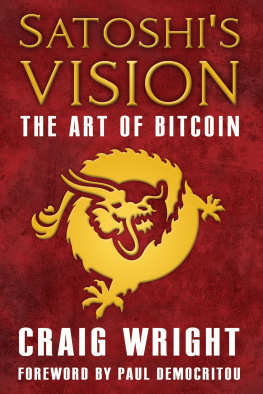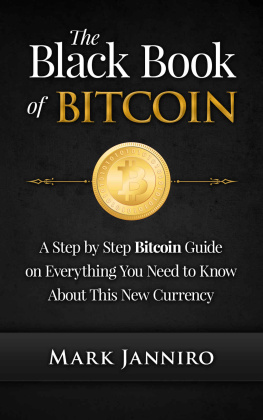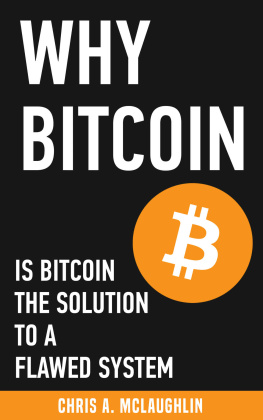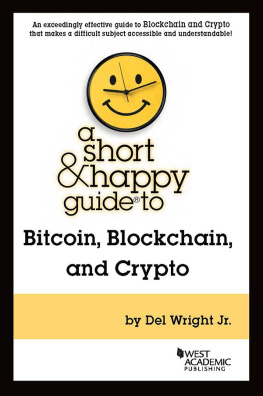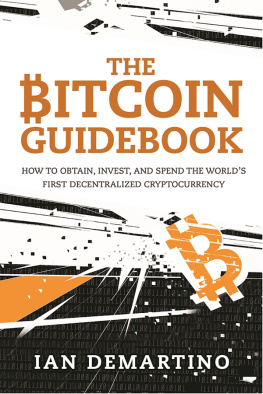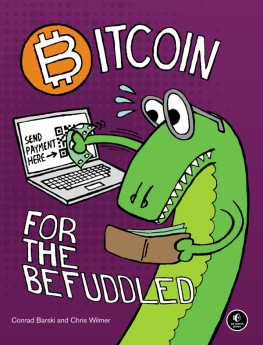Satoshis Vision
The Art of Bitcoin
Craig Wright
Satoshis Vision 2019 by Craig Wright.
All rights reserved. No part of this book may be reproduced in any form or by any electronic or mechanical means including information storage and retrieval systems, without permission in writing from the author. The only exception is by a reviewer, who may quote short excerpts in a review.
Interviews and Compilation by Paul Democritou
Edited by Sandra Seymour
The opinions expressed in this book are those of the author or speaker and do not reflect the opinions of Howson Books, its editors or affiliates.
Neither Howson Books nor its authors or editors guarantees the accuracy or completeness of any information published herein. Howson Books, its authors and editors shall not be responsible for any errors, omissions, or claims for damages, including exemplary damages, arising out of use, inability to use, or with regard to the accuracy or sufficiency of the information contained in this publication.
Nothing in this book constitutes legal, financial, or other professional advice. Information contained herein is current as of the date of publication to the best knowledge of Howson Books, its editors and authors.
Craig Wright
Visit my website at https://craigwright.net/
First Printing: August 2019
Howson Books
HowsonBooks.com
CONTENTS
Foreword
L OVE HIM OR HATE HIM, YOU CANT IGNORE CRAIG WRIGHT.
I had been interviewing some of the most influential people in the cryptocurrency industry for a little over a year when I first had the opportunity to speak with Craig.
Our first interview was conducted on video, for inclusion in the second edition of The Crypto Factor interviews book. But it quickly became obvious that to tell Craigs story, it would need a book of its own. Since then, I have conducted several more interviews with Craig, and used them, along with Craigs published blog posts and papers, to compile this book.
In Satoshis Vision: The Art of Bitcoin , Craig explains how the pseudonymous persona of Satoshi Nakamoto came about, where the original idea of Bitcoin came from, and why he stepped down from public interaction. He talks frankly about his original vision, and how Bitcoin as we know it today differs from that, concluding with his plans to bring the original vision to fruition, and what that means for the future of Bitcoin.
I cannot say that I agree with Craig on everything. We have had some lively discussions. But despite his prickly public persona, I have always felt comfortable in expressing my opinion with Craig and have nothing but the utmost respect for him as a person, and an entrepreneur.
Craig has a vision. That vision may or may not square with your own vision of what Bitcoin is or should be. He has opinions that may differ from yours, and rarely holds back in expressing them where his lifes work is concerned. Agree or disagree, you would be a fool not to listen to and understand Craigs arguments. Because Craig Wright is in the game for the long-haul. He expects establishing and perfecting Bitcoin to keep him busy for the next thirty years or more. By that time, he hopes you will be using his invention daily without even being aware of it, like plumbing.
Craig also has some startling and controversial predictions for the future of cryptocurrency in general and Bitcoin in particular. While it may be said that only time will tell whether Craigs predictions will turn out to be true, or whether the market will lead in a different direction, those predictions are based on extensive knowledge and experience, and participators in the field ignore that at their peril.
I would encourage everyone already involved in the cryptocurrency industry or considering investing, developing, or working within it to read and consider Craigs opinions and beliefs, and to keep an open mind.
Paul Democritou
Being Satoshi
I am Satoshi
O ne of the first questions most people ask when they question me about being Satoshi Nakamoto is where the name came from, and what it means.
Satoshi Nakamoto is an amalgamation of (Tominaga Nakamoto) and Ash Ketchum (; Satoshi).
The name wasnt something that I spent months and months on deciding, and it doesnt mean anything related to what you see on the wikis. Rather, it was an attempt at privacy.
The Tokugawa period of Japan, between 1603 and 1868 was an interesting period of isolationism in the country. The opposite of what was happening in the West. Yet there was a monk who also talked about trade, and he wrote a lot. In his writings he talked about the need for open trade, open economy. The same sort of things that Adam Smith talked about, except in the wrong country at the wrong time. That was Tominga Nakamoto.
Ash is called Satoshi in Japan. It was a light-hearted reference to Ash the Pokmon trainer. I thought it was a good play on words, because The Economist had released a cover with a picture of a phoenix rising from the ashes, and they were talking about the rise of a single world currency. I thought it was funny. That Bitcoin would be the world currency, rising from the ashes.
There was a secondary part of the name Satoshi. Satoshi Sugiyama was adopted by an American and given the name David Phillips. It comes from a book, The House of Morgan . David was adopted in both cases. David Kleiman was adopted, and so was Satoshi. I admired the characters in the book. It reminded me of a more glorious and honourable period in banking. Not something that we could go back to, but something we could remember when formulating Bitcoin. Pierpoint Morgan was an interesting character and one who proved himself through work.
But at base, the moniker, Satoshi Nakamoto, was simply a way of being able to work and have some privacy in my life.
Next, people ask questions along the lines of, Was Satoshi Nakamoto one person, or a group of people, and whether I wrote the original Bitcoin White Paper alone, or as part of a team effort.
The second question is easier to answer; I wrote the White Paper. There were some bits and pieces included which I had help with, and I had help with editing. But the White Paper is essentially my work. The matter of Satoshi being an individual or a group is a little more complex. Satoshi was a public persona I adopted, a part that I played. Yet even though I would say Satoshi was ninety percent me, other people helped, other people shaped the creation.
Invariably, people want to know why I felt the need for anonymity at the start. Why I dropped out of public sight, and why I chose to reappear and stake my claim to the Satoshi Nakamoto legacy after so many years away.
Put simply, I had concerns about the potential for illegal use of Bitcoin from the start, and the pseudonym was an attempt to put some distance between myself and that element. In the US, there are laws against the creation of software for the purposes of gaming. My concern was that these could be extended to money creation if the money created was then used for illegal purposes.
My past working as a prosecution forensic expert and in other roles with the government would not lead to a system that I could have publicly stood behind.
In order to fund my work, my partner Dave Kleiman and I sold code that was used in gaming out of countries such as Costa Rica. David took the biggest risk. Gambling is not illegal in Australia. But nothing Dave earned in Panama could be repatriated legally to the USA. On top of that, the mere issuing of coin was illegal. I wasnt American, but Dave was, so that was a problem.




